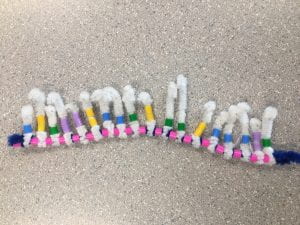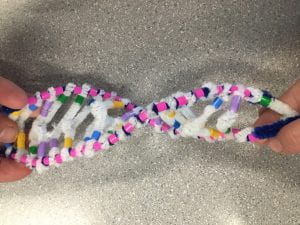DNA Structure:
Deoxyribonucleic acid (DNA) is a polynucleotide. Each nucleotide has a phosphate group, a deoxyribose sugar, and a nitrogenous base. Adenine and guanine are double-ringed purine bases. Cytosine and thymine are single-ringed pyrimidine bases. DNA has two “backbones” made up of alternating phosphate and sugar (represented by white pipe-cleaners) molecules. The nitrogenous bases are bonded to the sugar molecules. They can be in any order.
The two DNA strands are held together by hydrogen bonding between the nitrogenous bases. A purine always bonds to a pyrimidine; adenine pairs with thymine, forming two hydrogen bonds, and cytosine pairs with guanine, forming three hydrogen bonds. This is called complimentary base pairing. The strands run antiparallel to one another, with the 3’ end of one strand opposite the 5’ end of the other.
The DNA molecule twists in the form of a double helix.
This activity helps model the structure of DNA by using different coloured beads and pipe-cleaners to represent phosphate groups, deoxyribose sugars, and nitrogenous bases. It uses different numbers of beads to represent whether a nitrogenous base is a purine or a pyrimidine, and models how adenine always pairs with thymine and cytosine always pairs with guanine. It also models the DNA molecule in its double helix form. To improve the accuracy of this model, we could use more white pipe-cleaners to model how adenine and thymine form two hydrogen bonds versus how cytosine and guanine form three hydrogen bonds.
DNA Replication:
DNA replication occurs before cell division. During the replication process, exact copies of DNA are produced.
Unwinding and unzipping:
The enzyme DNA helicase causes the double helix to unwind and “unzip,” breaking the hydrogen bonds between the nitrogenous bases.
Complimentary base pairing:
Each strand serves as a template for the formation of a complementary strand. New complementary nucleotides—always present in the nucleus—fit into place by the process of complementary base pairing. This is carried out by the enzyme DNA polymerase. It can only “read” DNA from the 3’ end to the 5’ end. One backbone—the leading strand—gets complimentary nucleotides added from the top down, and the other—the lagging strand—gets them added in fragments from the bottom up.
Joining:
The nucleotides on the new strand form covalent bonds. The enzyme DNA ligase “glues” the fragments of the forming backbones to one another.
There are now two DNA molecules identical to one another and to the original molecule. DNA replication is semiconservative because each new DNA molecule has one old strand and one new strand.
This model was not a great fit for the process we were exploring. To model the complimentary base pairing, we covered most of the new backbone with a sheet of paper, only revealing the first few complimentary nucleotides. To model the joining of adjacent nucleotides, we used blue play-doh to represent DNA ligase gluing the fragments together. This activity was well suited to showing this process because it modelled how the three enzymes work in DNA replication. It was inaccurate in the way that it did not model how the complimentary nucleotides on the lagging strand are added in fragments.






